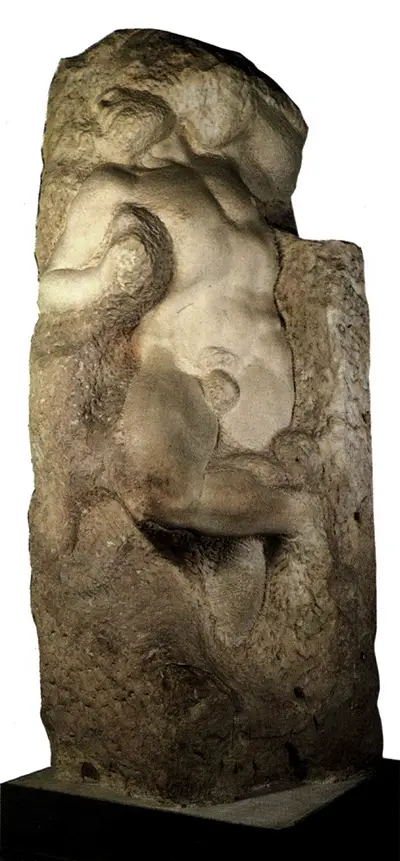The awakening slave is most powerful sculpture among the slaves in the series. The beautiful figure, which strikes an unnatural pose, is expressive and seems to be struggling to burst out of the marble block. One can almost feel the power and extra ordinary power that the prisoner wields.
This work was commissioned by Pope Julius II for his tomb. Originally, Michelangelo was supposed to carve more than 40 figures to surround Moses. However, after Julius II died, the project stopped because there was minimal funding and he could not find Mable to use for sculpting. Although Michelangelo was still pressured to complete the work, he was always busy with other art endeavours.
He eventually returned to work on them but did not complete some of them because he was not satisfied with them or he had changed plans. For this reason, most of the figures are incomplete and are fittingly referred to as Titan slaves.
Some argue that this state of incompletion and rough characteristics was necessary for the feel and impact of the pieces. They claim that the figures were intentionally left unfinished to represent the unending struggle of humans to be free from the trappings of material possessions. After his demise, his nephew donated four of the prisoners that were in his studio to Duke Cosimo I Medici.
Slaves of Michelangelo
Other slaves in different stages of completion are:
The young slave: This one is clearly defined than the Awakening slave. Also in a twisted pose, he traps himself by hiding his face in one arms and burying the other around his hips. He seems to be significantly younger than the other slaves.
The bearded slave: With a face with a thick, curly beard, this figure is nearly complete. It only has a section of his arms and his hands unfinished. The upper body is perfectly chiselled revealing the artist’s passion for his work.
The atlas slave: The figure is named after Atlas, a titan who held the world on his shoulders. This is because he is lifting a huge weight on his head and is struggling to emerge from the block.
The dying slave: This slave is the most frontal. Although it is referred to as the dying slave, it is believed that it’s not dying but is in a dream state.
Rebellious slave: This realistic structure bears resemblance to sculptures of prisoners in imperial Rome, hence the title rebellious slave.
Michelangelo believed that he was a tool of God. He said that he was not just creating but that he was revealing figures that were already in the marble. He worked on the figures for several years and took a lot of pride in his work. Unlike other artists, the sculpted free hand from the front moving to the back. It is clear that Michelangelo has an understanding of the human body and that a lot of care and detail went into carving the pieces. The prisoners stand with most of their weight on one foot with shoulders and arms twisting off axis to give them a powerful appearance.
This artist was very talented with his work demonstrating physical realism and understanding of the human psyche. For this reason, many powerful men of his time including religious leaders commissioned him. Other popular art included:
The painting of the 12 apostles: Michelangelo was requested to go to Rome to create a painting depicting apostles on the Sistine chapel’s ceiling. This is one of most popular pieces that build his career as it is in the Sistine’s chapel that popes are elected and commissioned .Over four years he painted the figures around the ceiling and filled the centre with pictures from Genesis. The most famous painting is that of creation where God and Adam reach to one another. It is after the completion of this project that he resumed working on the slaves of Michelangelo.
The Pieta and David: He received a commission from French cardinal Jean Bilhères de Lagraulas to create a statue depicting Virgin Mary with her dead son lying in her arms. The emotive painting continues to attract a lot of visitors to the basilica more than half a century later.
The iconic done of St. Peter’s Basilica: Michelangelo also worked on this piece which was completed after his death. He is also famed for creating other remarkable art such as Moses sculpture, and the last judgment painting.
The Awakening slave is a masterpiece that continues to attract visitors and impress many people long after its completion. Although the art is incomplete, it is clear from its detail that the artist put a lot of attention and effort into creating it. Four sculptures are kept at Gallery of the Academy of Florence, a museum in Italy. The rebellious and dying sculptures were complete figures which were sent as presents to King Francis and are now on display at the Louvre Museum in Paris. Everyone who lives in these countries or is visiting should see them.


